Like every other bird photographer many of the photos I take are not worth keeping. For the first few years I was shooting birds I estimated that I deleted 90% of my images. Now that I’ve become a little more discriminating that number is probably closer to 95%. Birds are incredibly difficult subjects – they’re fast, unpredictable, difficult to approach and generally uncooperative. When I’m culling images after a day in the field most shots fall under two main categories – keepers and garbage. But there’s often a few that are technically lacking for one reason or another but have some unusual or especially interesting feature that makes it difficult for me to trash them. So I don’t.
Occasionally I go back through them just for the fun of it. I enjoy them and thought some of you might too so here’s a few from the past month or so.
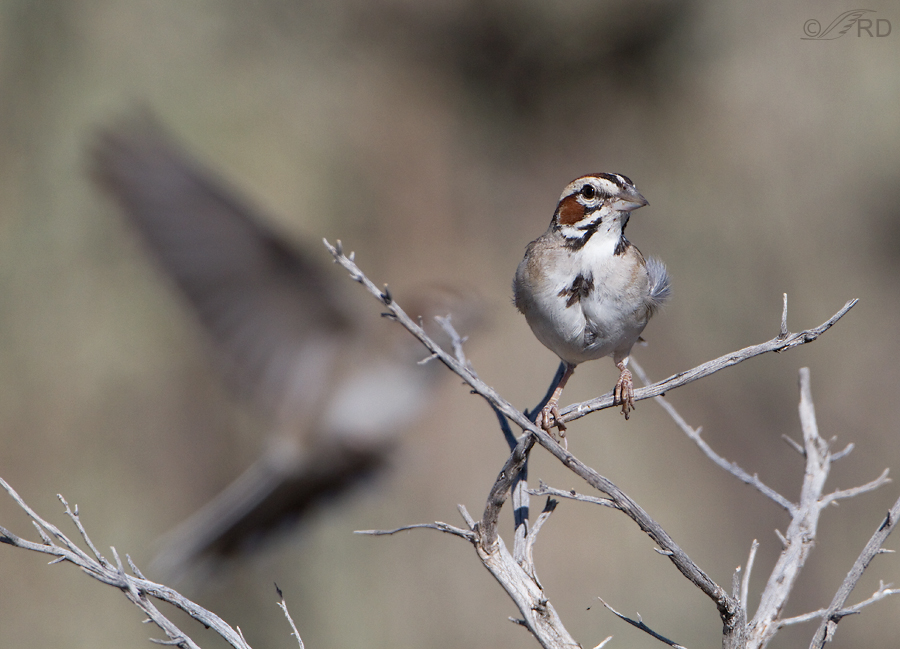
1/2500, f/7.1, ISO 500 500 f/4, 1.4 tc
This one’s from yesterday – a Lark Sparrow that posed and groomed for us for quite a while. Looking through the viewfinder I had no idea there was a second Lark Sparrow in the vicinity and didn’t even notice it flying through the frame until I got home and looked at it on my computer. Mia said that she’d noticed the second bird and that it chased the first bird away when it flew. Anyway, I thought the out-of-focus sparrow to the left was an interesting serendipity. I just wish the two twigs by the head weren’t there.

1/2500, f/7.1, ISO 500 500 f/4, 1.4 tc
And this is that same sparrow taking off. Many smaller birds often jump off the perch before opening their wings, just as this one is doing. Not the classic wing-up takeoff shot but it still has some appeal for me.
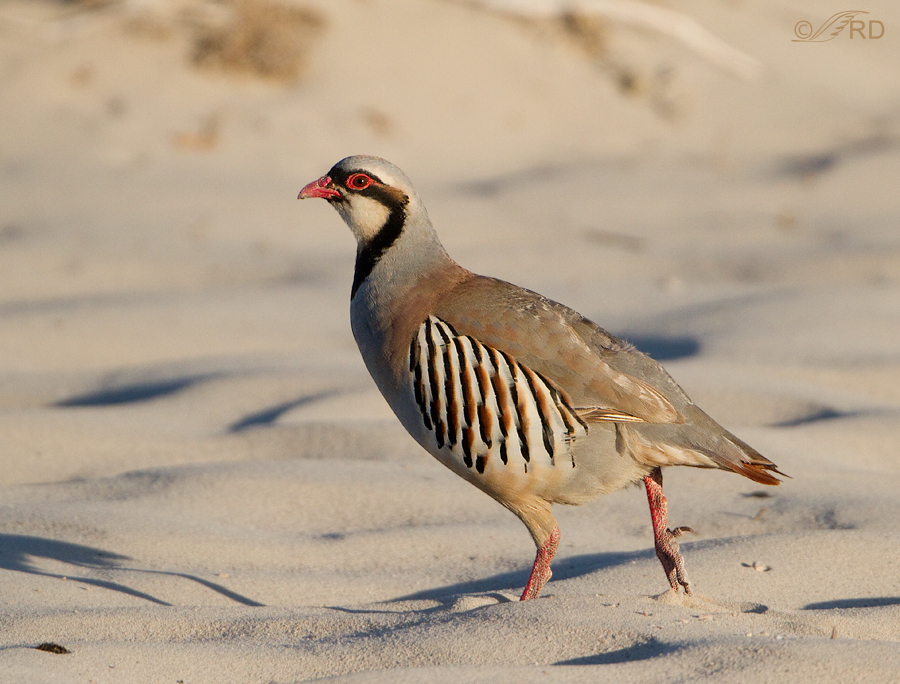
1/4000, f/5.6, ISO 640 500 f/4, 1.4 tc
Since Chukars prefer steep, rocky, mountainous terrain it always seems a little incongruous to me when I find them wading through the oolitic sand near the shore of the Great Salt Lake (more about that unique sand a little later in this post). I tend to enjoy images that show birds in habitats that are not classic for the species.
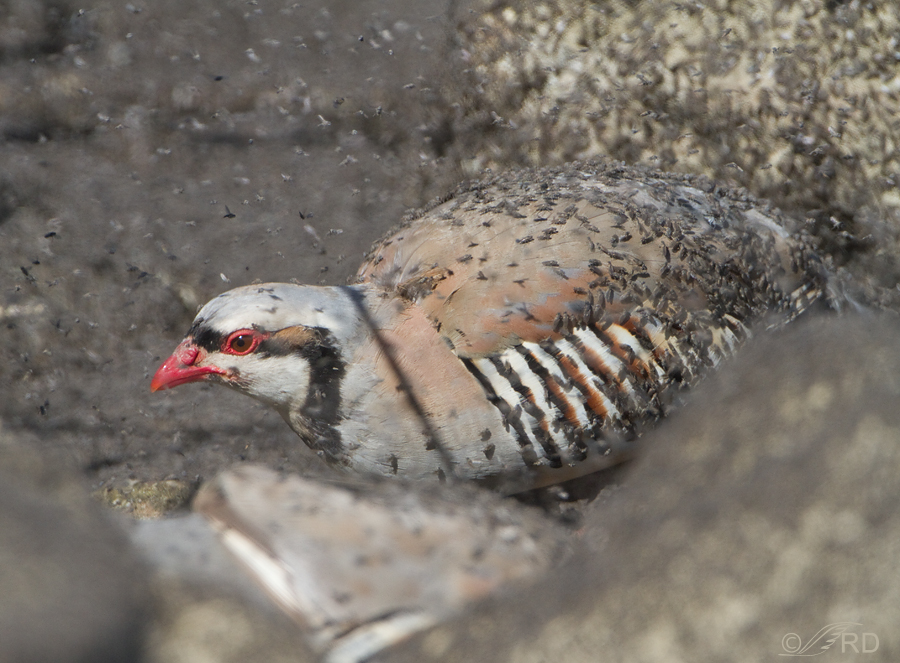
1/2000, f/6.3, ISO 500 500 f/4, 1.4 tc
Chukars are very nearly exclusive vegetarians but occasionally they do eat insects. Yesterday we found a family group (adults and half-grown juveniles) down at a rocky inlet of the Great Salt Lake and they were gorging themselves on brine flies (something I’d never seen them do before) though in this image it looks more like the flies were devouring the bird. The number of brine flies on the shores of the lake right now is of a magnitude that is difficult to comprehend. Thankfully they don’t bite. Though this is a ridiculously high angle on the bird I like the look at all the flies covering it.

1/1600, f/7.1, ISO 400 500 f/4, 1.4 tc
Two days ago we found this adult Pied-billed Grebe tearing a tadpole apart so it could feed the pieces to two ravenous chicks. This is a fairly substantial crop and not an image I’d normally keep but I wanted to document the red color in the bills of the chicks. I had never before seen grebe chicks with red on their bills and BNA says nothing about any red there though Mia has seen a small amount of much less intense red on their bills when she lived in Florida. Just something I found interesting.
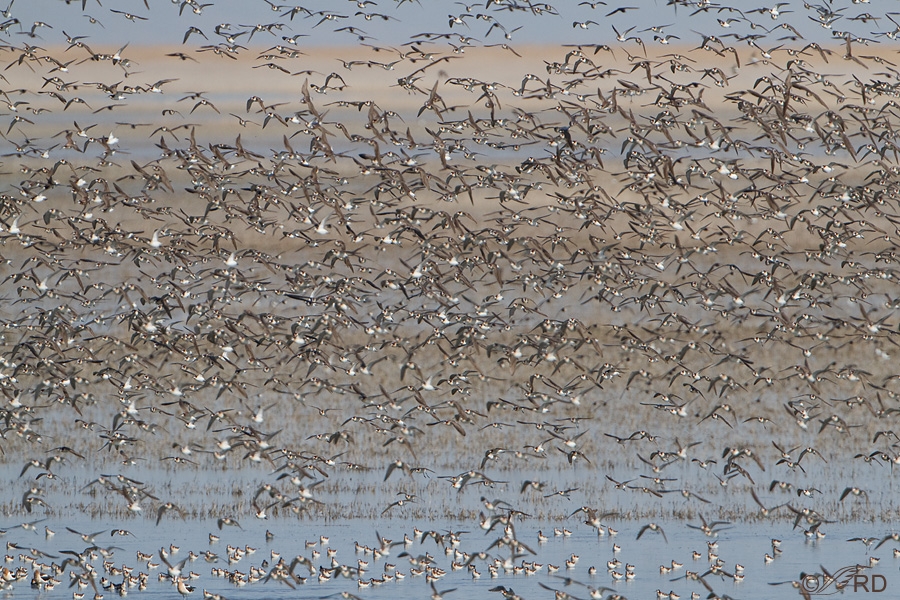
1/2500, f/7.1, ISO 500 500 f/4, 1.4 tc
About a week ago the number of Wilson’s Phalaropes along the causeway was simply staggering. There were easily hundreds of thousands of them and possibly into the millions. When they would take off en masse they would form murmurations, much like starlings and blackbirds are well-known for. To watch their ebb and flow in the sky was mesmerizing.
I’m disappointed in this image and I must make an embarrassing confession to explain why. This was taken with my 500mm and tc combination and doesn’t provide enough depth of field or width of scope to convey the tremendous number of birds. I knew that would be a problem with that gear so most of the images I took of this scene were with another camera and more appropriate lens but when I got home I found out that there had been no CF card in the camera and somehow the camera setting had been changed to allow me to shoot without a card. Sheesh, I just hate making rookie mistakes!
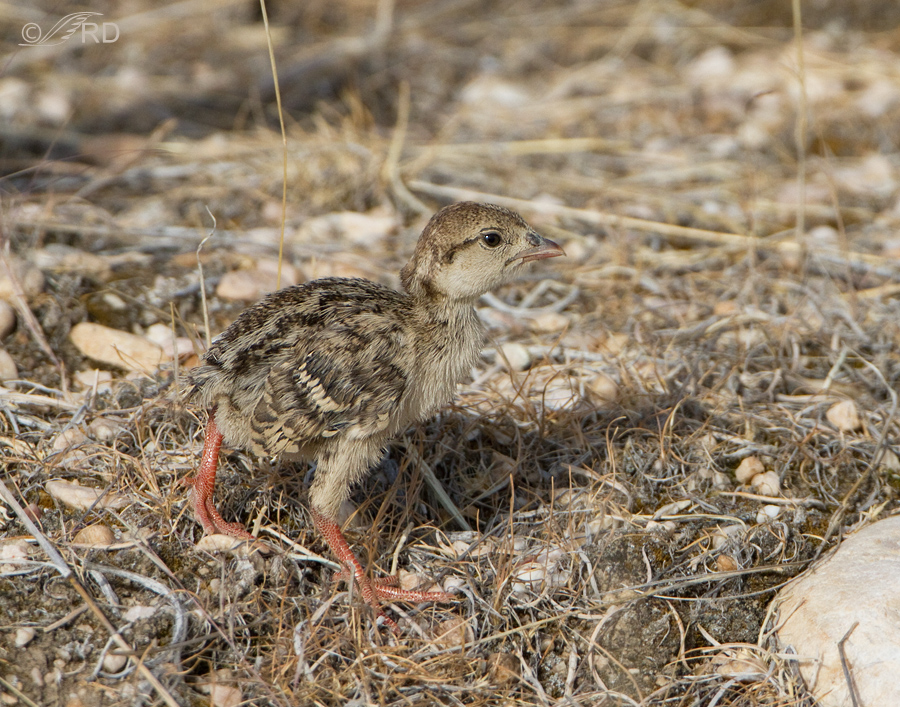
1/2000, f/7.1, ISO 500 500 f/4, 1.4 tc
I don’t get many opportunities with Chukar chicks and when I do the shooting angle is usually too steep when I’m shooting from my pickup but we found this youngster and almost a dozen of its siblings foraging relatively high along a steep bank next to the road so the angle isn’t quite so drastic. The setting is cluttered and busy but who doesn’t appreciate images of such young and helpless looking birds?

1/2000, f/6.3, ISO 500 500 f/4, 1.4 tc
But all our “ooh’s and aahs” and light-hearted banter over seeing so many cute chicks quickly disappeared when we noticed this tragic little bird trying (and failing) to keep up with the parent and the other chicks. It was hopping on one leg at a time and trying to negotiate all of the rocks and other obstacles that its siblings had no trouble with at all. Something was dreadfully wrong with this bird but even after analyzing dozens of photos I took of it I still have no idea what it was. At first I thought it must have a broken leg but it would alternate hopping on one leg and then the other. Perhaps it had neurological damage or some kind of birth defect but that’s no more than a guess. As it would try to hop over an obstacle while going up the hill it would usually fall back and land on its back or face as it’s about to do here. We instinctively wanted to help the bird but there was really nothing we could do and the policy of Antelope Island State Park is to let nature take its course (which I agree with). I thought about this little bird for much of the hour-long ride home.

1/000, f/6.3/ ISO 500, 500 f/4, 1.4 tc
Earlier this month I came across this mating pair of Cinnamon Teals. When the male mounted the female his weight pushed her entire body underwater – including her head. The whole process probably lasted over a half-minute and it seemed the female was in danger of drowning but the male would repeatedly grasp the feathers on the top of her head and pull her face and bill above water which enabled her to breathe. The birds were far away so the crop is larger than I like and I would normally have deleted the image but the seeming chivalry of the male in preventing the drowning of his “true love” must have brought out the romantic in me so I kept the image.
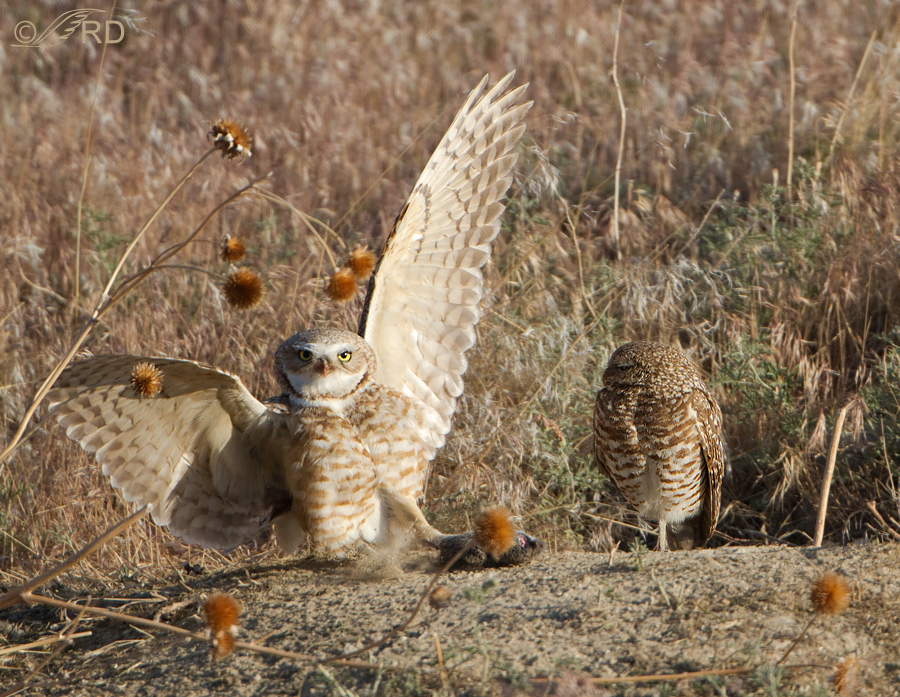
1/2000, f/5.6, ISO 640, 500 f/4, 1.4 tc
I’ve mentioned before on this blog my love-hate relationship with all the dried sunflowers from last year that dominate the landscape of much of northern Utah this time of year. They make wonderfully photogenic perches for passerines but they can also sure ruin a good image. There’s just so many of them that it’s often difficult to get an unobstructed view of your subject.
We found this pair of Burrowing Owls a month ago today on the west side of Utah Lake. They had at least 8 and possibly 9 chicks that they were trying to keep fed with voles. Typically the chicks would stay in the burrow (which can be seen behind the adult on the right) while one of the parent birds hunted and the other one stood guard at the nest entrance. To avoid disturbing the owls we stayed at a respectable distance from the burrow on the far side of a ravine which made the birds fairly small in the frame so I decided to try to get some images that included one of the birds landing, knowing the wings would help to fill the frame.
Well, this is the best image I was able to get (you can see the dirt being kicked up by the landing) and wouldn’t you know it – there’s a sunflower head right in front of the vole. Drats!
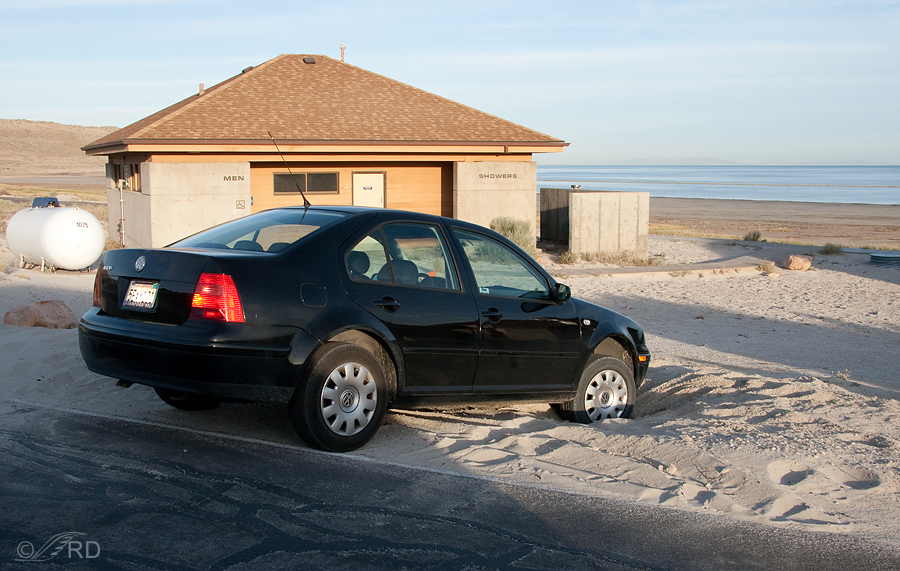
Now to a bird of another feather – in this case a dodo of sorts. The sun had only been up for a few minutes when we ran across this car, abandoned and stuck in the oolitic sand of Antelope Island. Despite the abundance of signs all over the island admonishing motorists not to leave the roads, the driver of this California licensed VW Jetta apparently decided to see how well his/her front-wheel drive could negotiate the sand. Well, this is not California beach sand! Oolitic means “egg stone” and this sand is well named as each grain is oval in shape and is actually produced in the lake rather than from weathering from higher slopes as is the case with most sand. Oolitic sand is formed by the precipitation of calcium carbonate around a nucleus of brine shrimp poop.
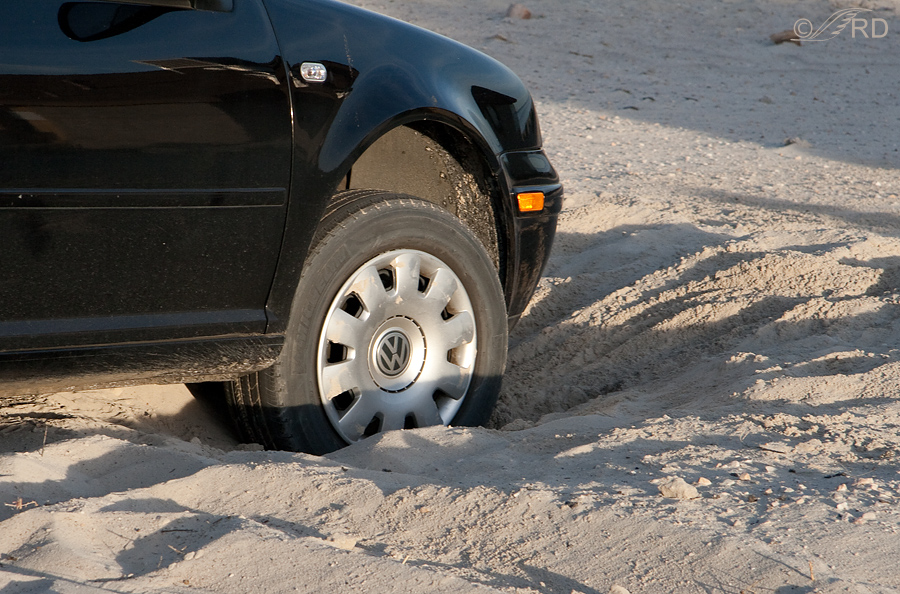
While most sand grains are highly angular, the smooth rounded shape of oolitic sand means that the individual grains move very easily against each other so if you try to drive on it you immediately bog down. It would be like trying to get traction on top of a thick layer of billions of almost microscopic marbles. Here you can see where the driver spun his/her front tires, throwing sand in front of the car and burying the wheels more deeply in a vain attempt to back out before authorities could see what had happened (the law was broken when the driver left the road).
Ahhh, sweet justice…
Ron


I’m glad you posted the “flawed” images of wonderfully documented behaviors.
Thanks for the explanation about oolitic sand, too!
Ron,
I like these shots also. Great stories behind each one. Witnessing nature like you do, almost daily, has to be very rewarding. Thank you for sharing your witness.
Thanks Rohn. And yes, it is very rewarding, as you well know from your own time in the field. I fully realize that you appreciate these kinds of experiences as much as I do.
This is a wonderful group of pics, and I, not being an expert, had no quarrel with any of them. Thank you so much for the laugh at the end!
Thank you Tana. I’m glad you enjoyed those last two shots.
I’m with Mia on those last two shots. A good laugh. On the others, Ron, again you are sometime too hard on yourself. But I know that I am my own worst critic, too. So I know how you feel. I loved the whole collection.
Thanks a lot Bob. I guess it comes naturally for me to be critical of my own images.
You said I would like the last two images of this post.. they sure made me chuckle!
Figured you might Mia 🙂